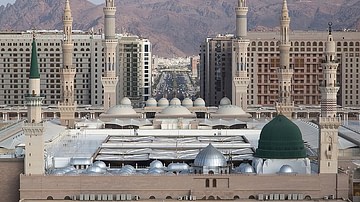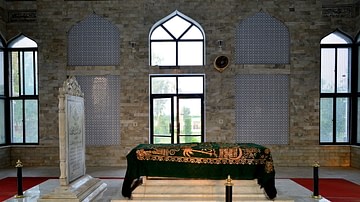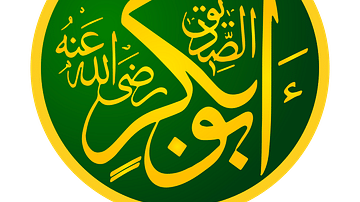
Leo Africanus (al-Hasan ibn Muhammad ibn Ahmad al-Wazzan al-Fasi al-Granati, 1485-1554) was a diplomat, merchant traveller and scholar who famously voyaged from Timbuktu to the Niger River and wrote 'The Description of Africa' (La Descrittione dell'Africa, 1526). Captured by Mediterranean pirates, he so impressed them with his learning and linguistic ability, that they gifted him as a slave to Pope Leo X (1498 -1526).
Leo Africanus was born into a family of clerics and accountants to the court of the Nasrid Dynasty (1238-1492) of Granada during the last days of their rule over the Emirate of Granada. Hasan was baptised Johannes Leo Africanus, and known in Italian as Giovanni Leone. He trained as an Islamic scholar and became a diplomat, travelling across West Africa, from Cairo and Aswan across to the Hejaz and Syria. It was during his return journey from Egypt that he was kidnapped by Mediterranean Christian pirates and ended up becoming a slave to the Vatican Pope Leo X (born Giovanni de’ Medici). Pope Leo X offered Hasan his freedom on condition that he converted to Christianity.
Leo Africanus' scholarship and translations from Arabic inspired early modern ideas of Africa and the Islamic world. His work Descrittione dell'Africa became a blueprint for European explorers seeking to monopolise trade and resources from the African subcontinent. Some historians believe that William Shakespeare’s (1564-1616) Othello is based on Leo Africanus. Descrittione dell'Africa was widely read in Europe. It became an important resource and guidebook on Africa, until the European colonisation during the 19th century.
Hasan al-Wazzan
Hasan al-Wazzan’s father, Ahmad al-Wazzan was a cleric in the court of Abu Abdallah Muhammad XII (c. 1460–1533), known in Europe as Boabdil. Hasan’s forbearers worked as aids to the court muhtasib of Granada – a magistrate who oversaw merchant trade and accounts, while also upholding morality and decorum in the public sphere. Hasan grew up alongside his father and grandfather under the influence of the Nasrid court. As a child, he spoke Arabic at home and Spanish in the streets.

In 1492, after a decade long war, Boabdil surrendered Granada to the Spanish Catholic monarchs Isabella I of Castile (1451-1504) and Ferdinand II, King of Aragon (1452 –1516), marking the end of 700 years of Muslim rule. Hasan’s family may have left Granada before 1492, or they could have stayed until the Reconquista. Hasan was a young child when his family, like many Andalusian migrants, fled persecution under the new Christian monarchs, crossing the Mediterranean to settle in Fez. Luckily Hasan’s family was well connected thanks to his uncle, already settled in Fez, who was a diplomat to the Wattasid rulers, serving Sultan Muhammad al-Shaykh (1490-1557). Consequently, they secured a home in a prominent quarter of Fez. His father purchased land north of the Rif Mountains and rented a castle above Fez. Other emigrant families from Granada however struggled greatly in Fez and complained publicly.
Early Years in Fez
Hasan’s education began at a neighbourhood school where boys learned to read and write Arabic and memorise the Quran. After reciting the Quran from memory, he graduated to the madrasa in Fez. He also studied at the Bu `Inaniya Madrasa and the famous University of al-Qarawiyyin, one of the oldest universities in the world, founded by an Islamic woman scholar named Fatima al-Fihri (born c. 800) from 857-859. His classes comprised Arabic grammar and rhetoric – especially poetry, religious doctrine, and Islamic jurisprudence (fiqh). As a student, Hasan also worked at Fez Hospital as a notary for a couple of years, earning his university fees.
Hasan travelled as a young boy to the Rif Mountains and family property outside Fez. He also accompanied his father on processions to the Middle Atlas Mountain ranges. When he was 12 years old, he travelled to Safi along the Atlantic coast. In his writings, Al-Wazzan also records trips during his youth much further afield – as far as Armenia, Babylonia, Central Asia, and Persia.
After completing his formal education, he accompanied his uncle on a diplomatic trip to Gao and Timbuktu in West Africa, presumably to form ties with the wealthy and powerful rulers of the Songhai Empire (c. 1460 - c. 1591). Following the success of this mission with his uncle, Hasan embarked on diplomatic missions of his own, representing the Sultan of Fez along with other local monarchs. He travelled far and wide across sub-Saharan Africa, Egypt and North Africa, Portugal, and Ottoman Turkey, perfecting his skills in military strategy, political diplomacy, and fiscal negotiations in addition to becoming an erudite scholar. In the summer of 1518, Hasan boarded a ship from Cairo to return to Fez, but pirates ensured he ended up in Rome instead.
Enter Johannes Leo de Medici (Leo Africanus)
In 1518, Christian pirates presented Pope Leo X with the gift of a Moorish diplomat and scholar as a slave. Hasan al-Wazzan was gifted to the Catholic Church to commemorate the lucrative attacks on Muslim ships crossing the Mediterranean at a time when the Ottoman Turks lurked threateningly at Europe’s heels.
Muslim scholars travelled widely, carrying books, papers and pens so that they could study and write while on a voyage - whether on horseback, in a caravan or ship. The Muslim literary genre of the rihla was a medieval precursor to the modern travelogue. Accordingly then, “Late at night on a boat going up the Nile to Qina, al-Wazzan was in his cabin, ‘studying by candlelight’ long after everyone was asleep” when he was captured by Pirates. (Zemon-Davies, p.54)
By October 1518 Rome was abuzz with rumours about the Muslim diplomat captured by the Italian pirates and Hasan’s arrival in Rome was highly anticipated. He became a prisoner at the ancient Vatican fortress of Castel Sant’Angelo. In addition to its dungeon prisons, the Castel also had separate luxurious living quarters, libraries, and collections where the pope and his advisors spent the hot summer months. In 1519 while still a prisoner, Hasan signed his name on a manuscript from the Vatican library that he had been allowed to borrow. Rather than being confined to the dungeons of the castle where the pope’s enemies were held, then, he had clearly been given the freedom and privilege to move about the castle and use the library.
Hasan perhaps practised his Latin and Italian while looking through the Vatican library and the pope’s advisors examined the books and papers he was carrying. During his audience with Pope Leo X, perhaps impressed by Hasan’s intellectual abilities, his court manners and extensive knowledge of Islam and the Muslim world – or maybe just to save what for him would have been a heathen soul, Pope Leo X offered Hasan freedom and a career as a scholar in Italy if he would first convert to Christianity.
Hasan al-Wazzan was an astute politician and diplomat. Pope Leo’s hostility to the Islamic world was likely well-known to him. He understood the acute threat possessed by the Ottoman Empire. Therefore, he quickly realised, like many before and after him, that conversion was his best course of action. Pope Leo X charged two of his trusted bishops with the task of catechizing Hasan and educating him in Catholic liturgy: Paride Grassi, bishop of Pesaro and the Vatican’s master of ceremonies; and the pope’s former tutor, Giovanni Battista Bonciani, bishop of Caserta. Hasan also studied Christian manuscripts from the Vatican library in Arabic. He impressed his European educators as an accomplished scholar and polymath. Bishop Grassi would write in his diary that Hasan was
Truly learned, … for in his language he is said to be most expert in philosophy and medicine, on which count, many philosophers and physicians came to dispute with him. And to universal praise, he corrected manuscripts in the Arabic language, which in many places were falsely, foolishly and badly interpreted.
(Grassi, Diarium, vol 2, 309v)
During the Feast of Epiphany on 6 January 1520, Hasan was baptised Johannes Leo de Medici, effectively Pope Leo X’s adopted son. However, historians would remember him as Leo Africanus.

Three key figures from the Vatican offices became Leo Africanus’ godfathers, supervising his spiritual and intellectual development. Pope Leo X also arranged a mutually beneficial office for him whereby he could gain an income in return for his expertise in the Arabic language, Islamic doctrine, and jurisprudence, as well as his knowledge of the political machinations of powerful Islamic entities operating in the Mediterranean region. He lived in the Campo Marzio in Rome at the Church of St. Augustine where one of his godfathers Cardinal Egidio (Giles) da Viterbo was head of the convent. Although Egidio was critical of the Islamic faith, like his fellow followers of Renaissance humanism, he was eager to learn about the intellectual thought of the Arabs.
Major Works
The surviving works of Leo Africanus in Latin include:
- 1. De Arte Metrica Liber
- 2. The Epistles of St. Paul in Arabic
- 3. Al-Quran in Arabic and Latin, translated and annotated by Johannes Gabriel of Teruel corrected and annotated by al-Hasan al-Wazzan
- 4. Arabic-Hebrew-Latin Dictionary
- 5. De Viris quibusdam Illustribus apud Arabes
- 6. De Viris quibusdam Illustribus apud Hebraeos
- 7. Libro de la Cosmographics [sic] et Geographica de Africa (published as Descrittione dell'Africa by Giovanni Battista Ramusio)
The Descrittione dell'Africa cites several other works of Leo Africanus that have not survived:
- 8. La brevita de le croniche mucamettani
- 9. Operino in la fede et lege di Mucametto secundo la Religion di Malichi
- 10. Le Vite di li Philosophi arabi
1. De Arte Metrica Liber
The papal secretary Angelo Colloci presided over a Renaissance fraternity in Rome that espoused humanism and along with it a keen interest in Arab scholarship. Leo Africanus, hailing from a family of weighmasters, fed Colloci’s keen appetite for knowledge about Arabic numbers – both for calculating weights and distances and as symbols in numerology and the occult sciences. Leo Africanus compiled this knowledge into one of his first Latin texts, on the arts of Arabic metrics. The surviving manuscript was copied in 1527 by an Italian scribe.

2. The Epistles of St. Paul in Arabic
After the death of Pope Leo X in December 1521, Leo Africanus worked with other important figures in Renaissance Italy. One was Alberto Pio, prince of Carpi and a diplomat representing various European monarchs to the pope. Pio was interested in Aristotle and the learning of the ancient Greeks much of which had come to Europe via Arabic translations and commentaries. He collected manuscripts and artefacts in Arabic, Hebrew and Syriac. Around 1521, he commissioned a transcription of the Arabic epistles of Paul the Apostle from Leo Africanus. Leo also most likely translated and summarised important works of Arab scholarship from the prince’s collection.
3. Al-Quran in Arabic and Latin
In 1525, Leo Africanus was living at Cardinal Egidio’s (Giles Antonini, O.E.S.A) residence in Viterbo as his Arabic tutor. In 1518 Egidio had commissioned a Latin translation and Arabic transcription of the Quran from Johannes Gabriel of Teruel. Johannes Gabriel was an Aragonese Muslim scholar from Teruel who was most likely forced to convert to Christianity in 1502, after the Spanish Reconquista. Leo, who excelled in Arabic while studying in Fez, clarified obscurities and errors of translation in Johannes Gabriel’s text. His corrections and annotations were recorded in a revised manuscript of 1525.
4. Arabic-Hebrew-Latin Dictionary
Leo Africanus travelled outside the environs of Rome with Cardinal Egidio, first to Viterbro in the countryside just outside the city and later to Bologna where Neo-Platonists and Kabbalah enthusiasts congregated. In 1523, he met in Bologna the Jewish physician and translator Jacob Mantino. Mantino invited him to collaborate on the compilation of an Arabic-Hebrew-Latin dictionary. Leo Africanus was enthusiastic about this project, perhaps seeing in it a connection to the centuries-old tradition of Arabic lexicography. He contributed 5,500 entries to the dictionary, while Mantino produced 170 Hebrew entries and 230 Latin entries. An additional 238 Latin entries were added later. Leo Africanus signed the dictionary with both his Arabic and Latin names. The dictionary was first published in 1664 by Johann Heinrich Hottinger.
5. De Viris quibusdam Illustribus apud Arabes
6. De Viris quibusdam Illustribus apud Hebraeos
These two books, “On Some Illustrious Men Among the Arabs” with an additional section titled, “On Some Illustrious Men Among the Jews” are copies made by an Italian scribe in 1527 of Leo Africanus' manuscript written sometime earlier, perhaps around 1523-1525. They are modelled roughly after the Arabic literary tradition of the tabaqat, a compendium of biographies organised thematically and chronologically by rank and class with details of genealogy, birth, death, marriage, children, and important contributions to scholarship or otherwise. Leo Africanus adopts this genre for his European audience, writing from memory and changing the organisation of details as he sees fit.

7. Libro de la Cosmographics [sic] et Geographica de Africa
This work, published as Descrittione dell'Africa (The History and Description of Africa) by Giovanni Battista Ramusio, is by far Leo Africanus' most important. Combining key genres of Islamic literary scholarship, it is in part a travelogue and geography as well as a memoir; there are debates and asides on theology, mysticism and jurisprudence, peppered with interesting anecdotes and quotes from a vast lexicon of Arabic poetry. It is written in nine sections beginning with a general introduction that encompasses climate, culture, economy, geography, politics or governance and social organisation. The next seven chapters cover deserts, mountain ranges, towns and villages in a specific region of Africa; the people who live there – their habitats, customs and livelihoods. In modern day terms, Leo Africanus might have been a political scientist. As the excerpt below illustrates, he possessed a keen understanding of the confluence of political, economic, and communal ties for maintaining social cohesion:
Moreover those which possesse the deserts bordering upon the kingdomes of Tremizen and Tunis may all of them, in regard of the rest, be called noblemen and gentlemen. For their governours receiving every yeere great revenues from the king of Tunis, divide the same afterward among their people, to the end they may avoid all discord: and by this meanes all dissension is eschewed, and peace is kept firme and inviolable among them. (Pory/Leone, p.158)
The final section discusses animals and birds, minerals, plants, rivers, and waterways. Interestingly, it does not include maps. This is a glaring omission since Muslim travelogues and books on geography are known for their feats of cartography. That Leo Africanus wrote his most complex and ambitious work in Latin is an admirable accomplishment, one wonders, however, if it might have had a different flavour had he written it in his mother tongue of Arabic.
The Vatican library holds a manuscript of the Libro de la Cosmographics [sic] et Geographica de Africa written by Giovanni Leone Africano in 1527. However, the book that has survived, been read and translated the world over is the edition published by Giovanni Battista Ramusio entitled, Descrittione dell'Africa. Several subsequent editions of Descrittione dell'Africa were published in Venice in the following decades. European translations emerged in Latin and French (1556), and English (1600) and German (1805). The book played a formative role in the creation of the idea of Africa in the European imagination.
Return to Tunisia
In 1526 while writing the Descrittione, Leo Africanus envisions returning to the Maghreb (North Africa), planning his next book. By 1527 Rome faced great turmoil. Ottoman armies had sacked Hungary and were circling Europe. Meanwhile, tensions between European Christian monarchs mounted. German and Spanish military troops ransacked towns along the Italian coast and by 6 May 1527, they had reached Rome. There is no concrete historical evidence of a journey home; however, most historians agree that Leo Africanus must have fled back to North Africa during this time. In 1532 Cardinal Egidio directed the Orientalist Johann Widmanstadt who wished to learn Arabic to Leo Africanus in Tunis. Interestingly, Leo returned to Tunis and not Fez. No further publications are attributed to Leo Africanus after 1526. His legacy lies in the scholarship he produced in Latin, whilst living in Italy. Historians surmise that Leo Africanus/Al-Hassan al-Wazzan died in Tunis around the year 1554.
Of the many interesting accounts of Leo Africanus' life, the historical fiction novel by Amin Maalouf, Leo Africanus (1986), written as a memoir is well-researched and fascinating.









